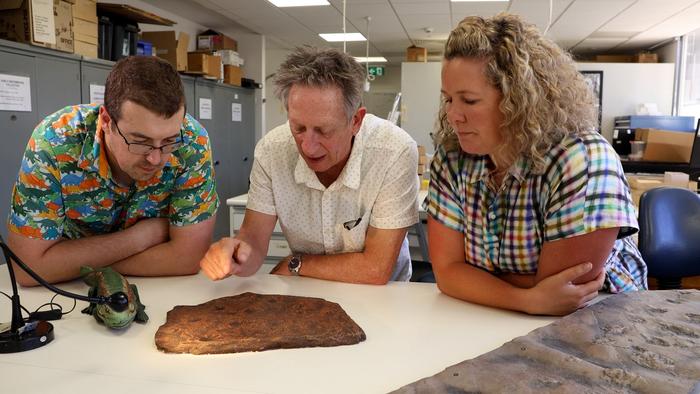A groundbreaking discovery from an Australian fossil site has dramatically shifted our understanding of reptilian origins, pushing their emergence back by an unprecedented 35 to 40 million years. This research, led by Professor John Long of Flinders University and published in the prestigious journal Nature, identifies the earliest fossilised tracks of amniotes—vertebrates with clawed feet and the capacity for terrestrial living—from the Carboniferous period, approximately 350 million years ago. These findings fundamentally recalibrate the timeline of tetrapod evolution and suggest that reptile-like animals first evolved in Gondwana, the ancient southern supercontinent that included present-day Australia.
The fossilised footprints were discovered in the Mansfield district of northern Victoria, a region long renowned for its rich palaeontological heritage. These trackways bear distinctive claw impressions, indicative of an amniote—likely a primitive reptile—rather than an amphibian. Until now, the earliest evidence of crown-group amniotes and other modern tetrapods was based on fossils and trackways dating from the Late Carboniferous period, roughly 318 million years ago, with body fossils no older than 334 million years and footprints about 353 million years old. This discovery’s older date rewrites this sequence, revealing terrestrial tetrapods were present tens of millions of years earlier than previously documented.
Professor Long, a strategic professor of palaeontology, explains that the implications of this discovery are profound for understanding tetrapod evolution. It suggests that all stem tetrapods and stem amniote lineages must have originated in the Devonian period, meaning tetrapod evolution advanced faster and more complexly than the fossil record had indicated so far. The Mansfield fossil trackways, characterized by a small, robust gait reminiscent of a modern goanna, provide critical insights into early terrestrial locomotion and ecology during a key evolutionary interval.
The path to this discovery spans over four decades. Professor Long’s long-term research in the Mansfield district began during his PhD studies, focusing initially on fossilized fish. It was only recently, through community engagement and field expeditions involving local amateurs Craig Eury and John Eason, that this exceptional slab bearing trackways was stumbled upon. Initial assumptions held that these tracks might belong to early amphibians, but close examination revealed hooked claws—a definitive trait of amniote footprints, which reshapes our understanding of when fully terrestrial vertebrates appeared.
Integral to this research was the collaborative effort with experts from international institutions. Dr. Alice Clement of Flinders University employed high-resolution digital scanning of the footprints, constructing detailed three-dimensional models that allowed precise morphological analysis. Working in conjunction with Professor Per Erik Ahlberg from Uppsala University, a recognized authority on vertebrate fossil records, the team applied comparative biomechanics and sedimentological context to validate the trackway’s identification and age.
Moreover, Dr. Aaron Camens, another coauthor specializing in ichnology—the study of trace fossils—utilized computational modeling to generate heatmaps of the footprints. These models delineated pressure points and gait dynamics, revealing behavioral traits otherwise invisible in skeletal fossils. Unlike bones, trackways encode direct evidence of an animal’s locomotive behavior, providing a dynamic window into its biology and interaction with the environment some 350 million years ago.
Dating these fossilized footprints involved a meticulous cross-referencing process. By comparing associated fish faunas found within the same rock strata from Mansfield to globally recognized assemblages with secure radiometric dating, the team constrained the fossil’s age within a narrow 10-million-year window in the early Carboniferous. This age framework reinforces the hypothesis that the early evolution of amniotes and terrestrial adaptation was centered within Gondwana, highlighting Australia’s critical yet underappreciated role in deep evolutionary history.
This discovery not only illuminates the evolutionary timeline but signifies a paradigm shift in palaeontology and vertebrate evolutionary biology. It challenges the long-held notion that modern tetrapods emerged predominantly in northern continents and instead supports a more complex, perhaps global geographic origination of terrestrial vertebrates. The research opens new avenues for exploring Gondwanan fossil sites, which might harbor additional clues about the diversification of early land animals.
Dr. Jillian Garvey from La Trobe University, who facilitated engagement with the Taungurung Land and Waters Council during the study, emphasizes the broader cultural and scientific importance of the find. According to Dr. Garvey, this remarkable milestone necessitates a renewed focus on Australian Gondwanan fossil records, as much evolutionary history remains hidden beneath southern soils, with the potential to further rewrite biological timelines on a global scale.
Published officially in May 2025, this study titled “Earliest amniote tracks recalibrate the timeline of tetrapod evolution” showcases how interdisciplinary and international cooperation can yield transformative discoveries. It underscores the dynamic nature of the fossil record, where new technologies and local contributions combine to challenge and refine scientific understandings that previously seemed settled.
Beyond its academic impact, the research stimulates public imagination about the richness of prehistoric life and the mysteries remaining in the fossil record. The Mansfield tracks act as a direct trace to an ancient world where vertebrates transitioned from aquatic to fully terrestrial ecologies—a defining evolutionary step that ultimately led to the rich diversity of reptiles, mammals, and birds inhabiting Earth today.
As investigations continue, the palaeontology community anticipates further revelations from these ancient Australian deposits. This remarkable fossil slab bearing clear, clawed footprints stands as a testament to the deep history embedded in the Earth’s crust, compelling scientists to rethink the tempo and mode of one of life’s most important evolutionary leaps.
Subject of Research: Animals
Article Title: Earliest amniote tracks recalibrate the timeline of tetrapod evolution
News Publication Date: 14-May-2025
Web References: http://dx.doi.org/10.1038/s41586-025-08884-5
References: Long, J.A., Niedźwiedzki, G., Garvey, J., Clement, A.M., Camens, A.B., Eury, C.A., Eason, J., & Ahlberg, P.E. (2025). Earliest amniote tracks recalibrate the timeline of tetrapod evolution. Nature. DOI: 10.1038/s41586-025-08884-5
Image Credits: Flinders University
Keywords: Amniote, Tetrapod evolution, Carboniferous, Fossil trackways, Gondwana, Palaeontology, Trace fossils, Early reptiles, Mansfield fossils, Vertebrate origins




